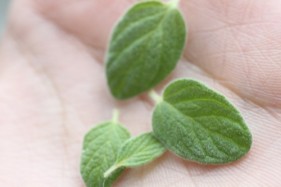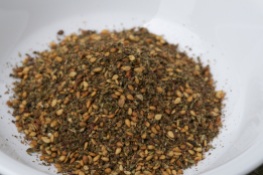post 134/365

Za’atar is a blend with deep historical and emotional roots. The smell is strong but not hot, rich but sharp, lemony and a little earthy. Za’atar has an amazing and unique flavor that is aromatic, and tangy at the same time. Eaten in the Middle East for centuries, Za’atar has a fascinating history. The word refers both to the alluring spice mixture that you eat at home, and to the wild oregano. It’s been part of the Mediterranean diet for thousands of years.
While each region has its trademark take on it, Za’atar usually consists of the same basic ingredients: Dried thyme, oregano, marjoram, sumac, toasted sesame seeds and salt. Za’atar is traditionally eaten as part of a healthy breakfast and is ideal as an aperitif or hors d’oeuvre. A small piece of bread is first dipped into the olive oil and then into the thyme, or the olive oil and spice mix is mixed together. Za’atar can also be used for cooking and is sprinkled over chicken, vegetables, salads and fish.
The name Za’atar alone most properly applies to Origanum Syriacum, considered by many to be the hyssop of the Bible. The origins of this name come from Greece and in ancient Greek language thymus stands for courage. Romans prepared baths with thyme and used them for good luck. Ancient Egyptians also believed that if you put thyme under the pillow, it would help with the memory and dreams. This word could be attested also in the Syriac satre, Arabic Za’atar, and possibly the source of Latin Satureia. There is evidence that a Za’atar plant was known and used in Ancient Egypt, though its ancient name has yet to be determined with certainty. Remains of Thymbra spicata, one species used in modern Za’atar preparations, were found in the tomb of Tutankhamun, as they incorporated them in the balsamic fluids, and according to Dioscorides, this particular species was known to the Ancient Egyptians as saem. Along with other spiced salts, Za’atar has been used as a staple in Middle Eastern cuisine from medieval times to the present
Pliny the Elder, a Roman author, naturalist, and natural philosopher, mentions Za’atar as an ingredient of the Regale Unguentum (Royal Perfume) used by the Parthian kings in the 1st century CE. Also the renowned 12th Century philosopher, astronomer, and physician Maimonides was a big fan of Za’atar. He regularly prescribed it to his patients to cure various ailments and to “open the mind”. Modern studies hint that he might have been right, as Sumac is full of flavonoids, and thyme and oregano are both packed with thymol, an essential oil, and carvacrol, a phenol. Both thymol and carvacrol have antioxidant, antiseptic and fungicide properties. Thymol has also been shown to help control coughing fits in patients with bronchitis (which might explain why Maimonides recommended Za’atar to treat colds).
Za’atar is the smell of home for most of us, it’s a spice mix that we have grown with and enjoyed on daily basis, and is a staple of our dietary food. Like our little country, it is packed with taste and flavors of this rich land drenched with sun. Just the whiff of it can bring memories of childhood morning breakfasts, walking in villages, of mothers, of Lebanon, of exam days, of the heat of the sun, of school, and of love.
A little recipe of a labneh toast I love:
- 1 small avocado (mashed)
- 2 tablespoons labneh preferably full fat (labneh baladieh)
- 1 tablespoon Za’atar
- Rye bread (I get mine from bread republic)
- Fresh thyme
- A drizzle of olive oil
Toast the bread, top with the mashed avocado and then with labneh, sprinkle the Za’atar, olive oil, and fresh thyme at the end. Sahtein!













The photos you took look amazing.
Great article and quick recipes.
Is the first picture jn the beginning of the article, Origanum Syriacum?
I’m surprised there are more comments.
LikeLike
Hello. Yes it is. Thank you for your message. There will be a post coming up later on about a lady who does it. I am trying to plan a visit as she lives far from beirut.
LikeLike
Hello. Thank you for your message. Yes it is. I have another recipe that I love super easy to do.
Heat in a clay pot some olive oil then add some chopped onion until they become transparent. Add some feta cheese with origano (I usually mix a couple) with some Nigela seeds and sprinkle some chili flakes on top. You know it’s ready when it starts melting! Sahtein ( means 2 health in lebanon, it’s like bon appetit)
LikeLike